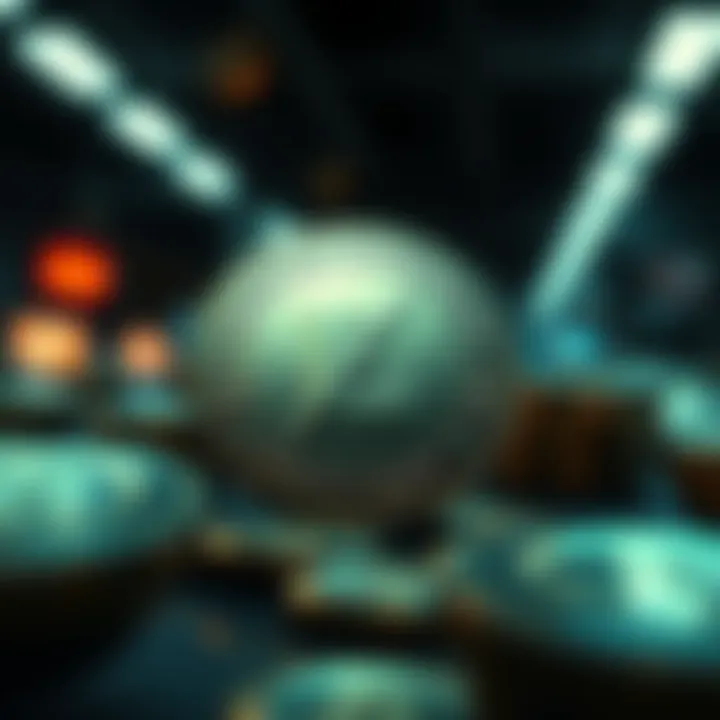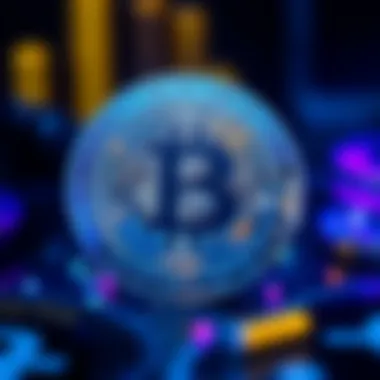NFT Cryptocurrency List: An In-Depth Exploration


Intro
In the rapidly evolving world of digital finance, non-fungible tokens, or NFTs, have emerged as a significant player, reshaping the very fabric of how we perceive ownership and value in the digital realm. Unlike traditional cryptocurrencies, such as Bitcoin or Ethereum, which are interchangeable and can be swapped for one another, NFTs are unique entities. Each token carries its own distinct value and attributes, often tied to digital art, collectibles, and virtual real estate, creating an intriguing landscape for both creators and collectors alike.
Getting a firm understanding of NFTs requires not just a glimpse into their nature, but also an exploration of the technological underpinnings and market trends steering this phenomenon. The objective of this article is to unravel the complexities that surround NFTs, their interrelation with cryptocurrencies, and the broader implications for digital assets.
Through a careful analysis of the current trends, emerging players, and pivotal innovations in blockchain technology, we aim to equip marketers, investors, tech professionals, students, and analysts with the insights they need to navigate this digital frontier. Let’s dive into the key concepts that form the foundation of this revolutionary market wherein creativity and technology intersect.
Understanding NFTs
In the realm of digital finance and technology, it is pivotal to grasp the nuances surrounding Non-Fungible Tokens (NFTs). These unique digital items are redefined through blockchain technology, making them quite unlike the currencies and assets we are accustomed to. Understanding the pivotal components of NFTs not only helps form a clearer picture of their functionality but also equips investors, marketers, and tech professionals to navigate this ever-evolving terrain.
NFTs have gained traction thanks to their distinctive characteristics, which allow for secure verification of ownership and authenticity. This characteristic makes them particularly attractive to artists, musicians, and various other creators looking to monetize their work on decentralized platforms. By delving into the details surrounding NFTs, one begins to appreciate their broader implications for ownership and creativity in the digital space.
What are Non-Fungible Tokens?
Non-Fungible Tokens are digital assets that represent ownership or proof of authenticity of a unique item, stored on a blockchain. Unlike currencies such as Bitcoin or Ether, which are fungible and can be exchanged on a one-to-one basis, NFTs are distinct and not interchangeable. Each token carries specific information or metadata, allowing it to signify ownership of something that is uniquely identifiable, such as artwork, music, or even tweets.
Characteristics of NFTs
NFTs possess several characteristics that differentiate them from other digital assets:
Uniqueness
The hallmark of NFTs is their uniqueness. Each token is one-of-a-kind and can have different attributes that make it special. This characteristic enhances the collectible value of NFTs, making them appealing to collectors and investors alike. Owning a unique digital item creates a sense of exclusivity, contributing to the buzz surrounding NFT markets.
Advantages of uniqueness include the potential for price appreciation and cultural significance; however, it could also lead to price volatility, as the demand for a specific NFT might fluctuate dramatically.
Indivisibility
Indivisibility means that NFTs cannot be divided into smaller units. While you can share or split traditional currencies, NFTs exist as whole tokens. This characteristic can significantly influence their liquidity and tradeability. It appeals to buyers who value complete ownership over partial stakes in assets.
This indivisible nature also reinforces the idea of ownership because one cannot simply own a fraction of an NFT; it's a whole entity. On the other hand, this means that potential investors must be prepared to deal with potentially higher purchasing costs, as they can't just buy a slice of their desired digital asset.
Ownership Proof
NFTs serve as a proof of ownership thanks to their integration with blockchain technology. Each transaction is rigorously recorded, ensuring that the history of ownership is transparent and verifiable. This characteristic is vital for artists and creators, as it helps to establish provenance and authenticity, significantly reducing counterfeiting concerns.
Yet, ownership proof may come with its complications. While you technically own the NFT, it does not always confer the full rights of the underlying asset it represents, which can spur misunderstandings and disputes over ownership rights.
Historical Context
The concept of NFTs is not entirely new; they have roots stretching back deeper into the blockchain’s history than many realize. The first known NFT emerged in 2017 with Cryptokitties, a game allowing players to buy, sell, and breed virtual cats. This initial incursion into the world of non-fungible tokens showcased the potential for unique digital items, paving the way for numerous applications across various sectors. As the technology progressed, applications blossomed in the fields of art, music, and real estate, making NFTs a focal point for contemporary discussions around digital ownership and asset management.
The Role of Cryptocurrency in NFTs
Understanding the relationship between cryptocurrency and non-fungible tokens (NFTs) is key to grasping the broader implications of digital assets. Cryptocurrencies serve as the backbone of NFTs, enabling these unique digital tokens to exist and thrive on various blockchain networks. The merging of these two revolutionary phenomena has created opportunities for artists, collectors, and investors alike, allowing for a new paradigm in how we perceive ownership, value, and creativity in the digital realm.
Key Cryptocurrencies Supporting NFTs
Ethereum
Ethereum stands out as the pioneer in supporting NFTs. Its blockchain introduced the concept of smart contracts, which allow for self-executing agreements without the need for intermediaries. This capability empowers creators to build unique digital assets with predefined rules. One significant characteristic of Ethereum is its large user base and developer community, which has fostered a rich ecosystem for NFT projects.
One distinguishing feature of Ethereum is its ERC-721 standard, specifically designed for creating and trading NFTs. This protocol enables detailed metadata storage, allowing each digital asset to carry unique attributes that make it distinct. However, Ethereum has faced criticisms, notably regarding its high gas fees, which can make transactions costly, particularly during peak usage times.
Binance Smart Chain
In contrast to Ethereum, Binance Smart Chain offers a more affordable alternative for NFT transactions. Known for its low fees and faster confirmation times, it has garnered attention from various NFT projects looking for cost-effective solutions. The key feature of Binance Smart Chain is its compatibility with Ethereum's assets, allowing easy migration of NFT projects.
A unique characteristic of Binance Smart Chain is its dual-chain architecture, which enables users to enjoy the advantages of both centralized and decentralized exchanges. While some might see this as a disadvantage due to potential centralization concerns, the benefits of efficiency and lower expenses often outweigh the drawbacks for users looking to engage in the NFT market.
Polygon
Polygon, formerly known as Matic Network, enriches the Ethereum network by providing a layer-2 scaling solution to improve transactional speed and reduce costs. This makes it an appealing option for developers who want a seamless operation for their NFTs while still leveraging the Ethereum ecosystem. A significant aspect of Polygon is its ability to process thousands of transactions per second, which is crucial in a market often characterized by high demand.


As a feature, Polygon supports Ethereum-compatible smart contracts, which facilitates interoperability with existing Ethereum NFTs. However, it is essential to note that the layer-2 solution also comes with its own set of vulnerabilities, given its reliance on securing transactions primarily through the Ethereum blockchain.
Smart Contracts Explained
At the heart of NFT transactions lie smart contracts. These are not merely lines of code; they are self-executing contracts where the terms are directly written into the code. This technology enhances transparency and trust between buyers and sellers.
Smart contracts automate processes such as the transfer of ownership and royalty payments to original creators. This is a game-changer for artists and musicians, as it ensures that they receive their fair share even when their work changes hands numerous times. The coded nature of these contracts minimizes the chances of disputes, fostering a safer environment for transactions.
Gas Fees and Transaction Costs
Transaction costs are a crucial aspect of interacting with NFTs, primarily driven by gas fees. When users execute transactions on platforms like Ethereum, they pay these fees, which serve as a form of compensation for miners validating the transactions.
Gas fees can fluctuate wildly, leading to unexpected costs during high traffic periods. These fluctuations often create barriers for new participants in the NFT marketplace, dissuading emerging collectors or artists from engaging due to the high costs. Furthermore, understanding gas management is vital for anyone looking to make investments in this space, as savvy users tend to time their transactions when fees are lower.
"Cryptocurrency acts as both the currency and the foundation for NFTs, bridging gaps and enabling opportunities in the digital asset world."
In summary, the synergy between cryptocurrency and NFTs provides both challenges and avenues for innovation. As the market continues to evolve, navigating the role of cryptocurrency in this domain will be crucial for anyone involved in the NFT ecosystem.
Popular NFT Platforms
In the ever-expanding world of digital assets, popular NFT platforms serve as the cornerstone for artists, collectors, and investors alike. These platforms not only facilitate the creation and trading of non-fungible tokens but also shape the landscape of how NFTs are perceived and valued within the broader cryptocurrency market. Understanding these platforms is crucial, as they influence the behaviors of users and impact market trends significantly. Some key considerations about popular NFT platforms include their user-friendliness, transaction fees, and the communities they foster.
OpenSea and Its Ecosystem
OpenSea stands tall as one of the premier marketplaces in the NFT space. It’s often dubbed the Amazon of NFTs, offering a wide array of digital assets—from art to in-game collectibles. The beauty of OpenSea lies in its user-centric design. This platform allows users to easily mint, buy, and sell NFTs without needing extensive technical know-how. Additionally, it supports a variety of payment methods, primarily Ethereum, which attracts a broader market audience.
Some notable features of OpenSea include:
- Large Selection: With millions of items listed, you're likely to find something that catches your eye.
- Community Engagement: OpenSea regularly collaborates with creators and communities, ensuring a vibrant ecosystem.
- User-Friendly Interface: The platform's design caters to both novice and experienced users, making navigation intuitive and efficient.
However, the platform isn’t without issues. Users often face high gas fees during peak times, which can be a deterrent for some buyers. Furthermore, the sheer volume of listings can make it challenging to discern quality from noise. Nevertheless, OpenSea remains a stalwart in the NFT realm due to its extensive network and community-driven vibe.
Rarible: A Decentralized Marketplace
Rarible distinguishes itself by being community-centric and decentralized, giving power to the users. Unlike centralized platforms, Rarible allows creators to set their own royalties, thereby fostering an environment where artists can profit sustainably from their work.
Key aspects of Rarible include:
- Governance Token (RARI): Users can earn RARI tokens through participation, which grants them voting rights on platform decisions.
- Fair Royalties: Creators can establish their royalty percentages, ensuring they receive a fair cut from secondary sales.
- User-Driven Features: The platform evolves based on user feedback, creating a sense of shared ownership.
This structure promotes a vibrant, dynamic marketplace; however, it may intimidate potential users who are not familiar with the principles of decentralized finance (DeFi). Despite these challenges, Rarible's unique approach appeals to many artists seeking more significant control over their work and its associated value.
Foundation and its Artistic Focus
Foundation is a platform explicitly tailored for artists and creators, emphasizing high-quality content over quantity. Its selective curation process ensures that only the most promising artists gain visibility, fostering an environment of respect and artistic integrity.
Notable features of Foundation include:
- Curator Support: Established creators can invite new artists, enabling a community of mentorship and collaboration.
- Focus on Quality: The platform prioritizes well-crafted digital art, reducing the clutter often seen in broader marketplaces.
- Event-Driven Sales: Foundation often holds timed events or auctions, which generate buzz and excitement around new drops.
While the exclusivity can create a barrier for emerging artists, it also elevates the perceived value of items listed on the platform. This niche focus on artistry has helped Foundation attract serious collectors, who appreciate the stringent curation process.
"The combination of community, technology, and art on these platforms redefines what ownership means in the digital age."
As the landscape of NFTs continues to evolve, understanding these platforms provides crucial insights into the mechanisms driving the NFT movement. Each platform offers distinct benefits and challenges, making it imperative for collectors and creators alike to choose wisely based on their specific needs.
The NFT Market Landscape
The landscape of the NFT market is pivotal to understanding how digital assets are reshaping economies and cultures. As these tokens gain traction, analyzing the market dynamics, growth, and trends becomes essential for marketers, investors, and tech professionals looking to capitalize on this burgeoning sector. This section offers a closer look at the evolution of NFT sales and the forces at play, providing insights into the valuation of these unique assets.
Market Growth and Valuation
The growth of the NFT market has been nothing short of meteoric. Starting off as a niche interest, it has burgeoned into a multi-billion-dollar industry. Recent studies estimate that the NFT market grew from $250 million in 2020 to an astonishing $10 billion in 2021. This rapid expansion highlights a shift in consumer behavior towards digital ownership, fueled by the allure of unique collectibles and the potential for investment gains.
Several factors contribute to the burgeoning valuation of NFTs, including market sentiment, the increasing adoption of blockchain technology, and the influx of institutional investments. Anticipation and speculation play significant roles, but actual utility within various sectors further drives interest. The ability to verify authenticity and provenance via blockchain is an exciting prospect, giving buyers confidence when they purchase these digital assets.


Trends Influencing NFT Sales
The NFT market is not just a passing fad; several trends are shaping its future.
Celebrity Endorsements
When high-profile figures dip their toes into the NFT waters, it sends ripples of excitement through the market. Celebrity endorsements serve as a catalyst for mainstream acceptance, making the concept of digital ownership relatable to everyday folks. Notable examples include musicians like Grimes and Snoop Dogg launching their own NFT collections, which not only generates buzz but also brings their fanbases into the fold. This kind of visibility captures a wide array of interest—from casual observers to serious collectors.
However, while celebrity involvement boosts visibility, it also raises questions of authenticity and value. Are these creations truly unique, or merely a cash grab? The risk is that when a fad fades, so might the value of these celebrity-linked NFTs.
Virtual Real Estate
A fascinating offshoot of the NFT sector is virtual real estate, where parcels in digital worlds are bought and sold for hefty sums. Platforms like Decentraland allow users to purchase land and develop it, sparking visions of futuristic metaverses. These transactions outline the ambition of creating engaging, interactive online experiences, thereby pushing the boundaries of digital ownership.
But, buying virtual land also has its traps. The question looms—what happens when the buzz subsides or alternatives become more appealing? Investing in virtual property carries both high rewards and significant risks, as market dynamics can shift swiftly.
Gaming Assets
Gaming assets represent another strong thread in the NFT tapestry. Each game comes with its own economy, allowing users to buy, sell, and trade in-game items as NFTs. This system transforms gameplay itself into an investment opportunity, where rare items can fetch remarkable prices. Gamers are no longer shackled to a single narrative; they can influence the assets they own, leading to a more personalized experience.
The allure of gaming assets, however, can vary drastically. What makes one weapon or character rare might not hold true in another game, leading to unpredictable market behavior. Thus, while the potential exists for tremendously high returns, so too does the chance of it tanking.
Impact of Seasonal Variations
Lastly, the NFT market is susceptible to seasonal variances, much like any other market. Historical trends have indicated that the activity spikes during certain periods, especially around holidays and special events. Awareness and curiosity increase when celebrities release new projects or when technological advancements make transactions smoother. Conversely, downtime can lead to erosion of interest and a stagnation of sales. Keeping an eye on these patterns ensures timely decision-making for investors and professionals engaged in the NFT ecosystem.
In summary, understanding the NFT market landscape is crucial for anyone who wants to navigate this ever-changing terrain effectively.
NFT Use Cases
The sheer versatility of non-fungible tokens (NFTs) makes them an exciting subject in today’s digital economy. Not only are they revolutionizing how we perceive ownership, but they also serve numerous practical purposes across various industries. By understanding the landscape of NFT use cases, both investors and creators can harness their potential in innovative ways. This section dives into the pivotal roles NFTs play in sectors like art, music, gaming, and even real-world assets, illustrating their transformative power and broad appeal.
Art and Collectibles
NFTs have carved out a significant niche in the art world. Artists are now able to tokenize their artwork, which provides a form of verification of authenticity and ownership that traditional art markets may lack. This shift democratizes access to art, allowing more creators to earn a living while retaining control over their work. By selling their art as NFTs, artists do not need to rely on galleries or auction houses, which usually take hefty commissions.
One standout example is the artist Beeple, who sold a digital collage as an NFT for a whopping 69 million dollars at Christie’s auction house. Such instances highlight how NFTs can turn digital art into a lucrative asset and facilitate a new appreciation for digital creativity.
Moreover, collectors now have the ability to acquire pieces that have unique provenance, adding value that can be tracked transparently via blockchain technology. However, not all that glitters is gold; aspiring collectors should tread carefully, as speculation can lead to inflated prices that may not stand the test of time.
Music and Entertainment Tokens
The music industry has also started to embrace NFTs, providing a fresh way for artists to distribute their work and maintain a more substantial share of their profits. By releasing music as NFTs, musicians bypass traditional channels like record labels, which have often dominated revenue streams. This enables direct fan engagement and a better revenue model for artists.
For instance, artists like Kings of Leon have released whole albums as NFTs, enabling fans not just to own the music but also get exclusive perks like concert tickets or even limited-edition merchandise. This filtration of revenue allows artists to reward their most dedicated fans while offering unique experiences.
Yet it’s essential to consider how this model might evolve. Will listeners be willing to embrace the idea of owning bits of music rather than owning the entire album? Only time will tell how these trends shape the future of music consumption.
Gaming Integration
The realm of gaming represents one of the most promising use cases for NFTs. Gamers increasingly seek ownership of in-game assets, and NFTs provide that. Within games, items can be tokenized, allowing players to buy, sell, or trade them on NFT marketplaces. This transforms assets like skins, characters, or even virtual real estate in games into tradable commodities.
For example, games such as Axie Infinity have popularized the concept of play-to-earn, where players earn NFTs through gameplay, making them potentially lucrative. The integration of NFTs in gaming opens pathways for completely new economic models, where the value of a player's time and effort in the game converts directly to digital assets.
On the flip side, developers must address concerns surrounding the sustainability and profitability of in-game economies, as the market can be volatile and speculative.
Real-World Assets
As unconventional as it sounds, NFTs are making their way into the representation of real-world assets. This bridging of physical assets to digital tokens allows for fractional ownership, where more people can invest in a property, for instance, without needing to purchase it outright. By tokenizing assets like real estate, cars, or vintage wines, NFTs can facilitate smoother transactions and clearer ownership records via blockchain.
A case in point is the real estate company Propy, which enabled transactions where buyers could purchase a home using cryptocurrency, with the deed represented as an NFT. As the real estate market becomes intertwined with blockchain technology, we may see an era of transparency and liquidity previously unseen in property transactions.
However, challenges remain in educating both investors and sellers about the nuances of combining tangible assets with digital ownership. Transparency and regulatory developments will be crucial moving forward to legitimize their use in this context.
"The future of NFTs is not solely about art or collectibles; it's about integrating them into our everyday transactions in meaningful ways."


In summary, as the technology supporting NFTs matures, we can expect an expansion in their application across various sectors, each providing unique benefits and challenges. Keeping an eye on these use cases will be vital for anyone involved in the cryptocurrency landscape.
Challenges and Criticisms of NFTs
Navigating the world of NFTs is not all sunshine and rainbows. Despite the rapid rise and allure of non-fungible tokens, the journey comes with its own share of potholes. Understanding the challenges and criticisms surrounding NFTs is crucial for both investors and enthusiasts. This section aims to dissect these issues, including environmental impacts, market fluctuations, and ownership rights, shedding light on the nuances that accompany this digital revolution.
Environmental Concerns
One of the first stumbling blocks in the path of NFTs is the environmental impact tied to their creation and trade. Many NFTs are minted on platforms that rely on proof-of-work consensus mechanisms like Ethereum. This method, while secure, requires an immense amount of energy to validate transactions and maintain the blockchain.
"The energy consumption of Ethereum is comparable to that of some small countries."
This reliance on energy consumption raises eyebrows everywhere, as environmental activists push for greener alternatives. The irony lies in the fact that NFTs, often seen as modern art and innovation, are criticized for contributing to climate change. Market demand for NFTs could put even more strain on an already burdened ecosystem.
Market Speculation and Volatility
Speculative trading is another hornet's nest buzzing around NFTs. Prices can soar to astronomical heights based on trends and emotions rather than their intrinsic value. Just a celebrity tweeting about an NFT can send its price rocketing into the stratosphere—even if it’s just a digital doodle that took a few minutes to create.
This rollercoaster atmosphere creates a high-risk environment where investments can be wiped out overnight. Investors need to be aware of the risks involved, as many have found themselves purchasing NFTs at peak prices only to watch their values plummet days or weeks later. The volatility isn’t just a nuance; it’s a defining characteristic of the NFT marketplace.
Issues of Copyright and Ownership
Lastly, the issues of copyright and ownership are treading dangerous waters. Just because someone owns an NFT doesn’t inherently mean they own the copyright of the associated artwork or digital asset. Many buyers mistakenly assume that purchasing an NFT grants full rights over the artwork; this can lead to significant legal conundrums down the line.
In some instances, artists have witnessed their work being sold as NFTs without their permission. The open nature of the blockchain makes it easy for this to happen, but it raises ethical questions about the responsibilities of both platforms and buyers. Navigating this grey area involves understanding licensing agreements, which can be a maze wrought with confusion.
The Future of NFTs
The future of non-fungible tokens (NFTs) promises to be a significant dimension in the ever-evolving digital asset landscape. As NFTs mature, they are expected to permeate multiple sectors, reshaping interactions, ownership, and monetization strategies. The ongoing dialogue surrounding the potential of NFTs underscores their relevance not just within the art and entertainment industries, but also in areas like real estate, identity verification, and virtual environments. This section seeks to explore emerging trends, market predictions, and possible regulatory frameworks that will pave the way for NFTs in the coming years.
Emerging Trends in NFT Technology
Technology never sits still, and neither do NFTs. Current trends suggest that NFTs are evolving beyond their traditional confines of digital art and collectibles. One emerging trend is the integration of interactivity within NFTs, where tokens are designed to change or evolve based on user interactions or external data influences.
Another trend involves the intersection of NFTs and virtual reality (VR). Users might experience ownership not just through static visuals, but also through engaging, 3D immersive environments. Imagine walking through a gallery where the art you own is displayed, evolving in real-time based on your preferences!
Moreover, the concept of fractionalized NFTs allows a broader audience to invest in high-value assets. By splitting ownership, more individuals can stake a claim in exclusive art pieces or unique memorabilia, effectively democratizing access to NFTs.
Predictions for Market Evolution
Looking ahead, several predictions point to a robust expansion in the NFT marketplace. Analysts opine that the market will not simply grow; it will fragment into specialized niches. We're likely to see tailored marketplaces catering to specific communities such as game developers, musicians, and graphic artists. This focused approach could enhance user experience by reducing the noise found in broader platforms.
Furthermore, integration with social media platforms can tap into existing user bases, allowing for seamless transactions where users can trade and showcase their collections directly through their profiles. As social media continues to merge with financial transactions, we may witness novel formats of ownership and community engagement that replace conventional ownership standards.
"The evolution of NFTs goes hand-in-hand with technological advancements that redefine ownership and authenticity in the digital realm."
Potential Regulatory Developments
As NFTs take center stage, regulatory bodies are beginning to pay more attention. The lack of clarity in regulations around crypto assets has left a grey area that may soon see new frameworks introduced to ensure consumer protection without stifling innovation. Some key areas of focus may include:
- Consumer Rights: Policies may enforce transparency in the sale of NFTs, ensuring sellers accurately represent ownership and provenance.
- Taxation Standards: As ownership rights are digitized and traded like assets, tax implications will arise, prompting discussions around the best frameworks for taxation in this new domain.
- Intellectual Property Rights: The question of copyright will take on new challenges. Regulators need to determine how to safeguard original creators while allowing for the lease or resale of digital content.
Navigating these waters will require input from stakeholders across the board, creating a collaborative approach between technologists, artists, legal experts, and regulatory agencies.
Closure
Bringing everything together, the conclusion of this article serves as a crucial moment for reflection on the interplay between NFTs and cryptocurrencies. It underscores not only the relevant technological advancements driving this digital revolution but also the emerging opportunities and challenges that stakeholders face. Whether you’re a marketer who needs to grasp the latest trends or an investor aiming to navigate the complexities of digital assets, understanding these concluding notes can be tremendously valuable.
Recapitulation of Key Insights
In closing, let’s summarize the primary takeaways from our exploration:
- NFTs are unique digital assets, underscoring the idea of ownership in the virtual realm. Their characteristics, including indivisibility and uniqueness, differentiate them sharply from cryptocurrencies like Bitcoin.
- Cryptocurrencies fuel the NFT ecosystem: Digital currencies such as Ethereum provide the backbone for transactions and smart contract functionality. It's clear that without these cryptocurrencies, the NFT marketplace would struggle to exist in its current form.
- The evolving landscape is ripe with changes: The NFT market is not static; it's characteriZed by new platforms, numerous use cases, and varying trends that can affect both their values and the engagement of investors and creators alike.
- Addressing the challenges is vital: Issues such as environmental impacts and copyright disputes paint a complex picture. Stakeholders must navigate these waters carefully, as they hold significant sway over the future of NFTs.
"As the lines blur between physical and digital, the only constant will be change itself."
Final Thoughts on NFTs and Cryptocurrencies
The convergence of NFTs and cryptocurrencies represents a significant chapter in the broader narrative of digital innovation. This relationship is not merely transactional but creates new paradigms for value exchange and creative expression. For tech professionals, marketers, and serious investors alike, the knowledge gleaned from this article should illuminate the potential pathways moving forward.
The importance of keeping an eye on emerging technologies, regulatory frameworks, and market dynamics cannot be overstated. As traditional assets and new digital creations collide, this new frontier of ownership demands a nuanced understanding. The future landscape will be defined by those who marry creativity with sound investment strategies, adapting to an ever-shifting environment.
As we step into this brave new world, remain curious, stay informed, and keep exploring the intricate dance between NFTs and cryptocurrencies.















